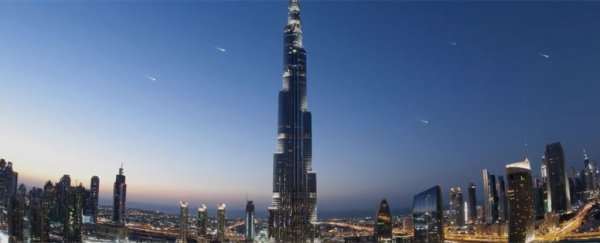If you thought Russia's recent efforts to prevent rain in the sky from dampening holiday spirits represented the ultimate in scientific stage management, you ain't seen nothing yet.
A Japanese research company called ALE Co. (aka Star-ALE) is bidding to put on a sensational pyrotechnics display for the opening ceremony of the 2020 Summer Olympics in Tokyo. But this is no regular fireworks show: ALE Co.'s 'Sky Canvas' is an artificially created meteor shower – uh-huh – which would see hundreds of tiny, coloured fireballs rain down over the host city.
According to a report by Rain Noe at industrial design site Core 77, if ALE Co. has its way, this amazing concept would result in the human-made shooting stars being visible from well outside of Tokyo too, with the next-level pyrotechnics expected to be viewable from up to 100 kilometres (62 miles) away from the city.
But how does it all work? ALE CO. says it can "artificially recreate" the process of natural shooting stars by sending up a satellite into orbit carrying a payload of between 500 to 1,000 specialised pellets called "source particles".
Once the particles – composed of chemicals designed to emit flames in various colours – are discharged from the satellite, they'd travel around Earth until they enter the atmosphere and begin to burn up. With numerous particles being discharged at the same time, the company says it can create a safe, on-demand meteor shower for the wonderment of the crowds below.
But wonderment comes at a cost, and in this case, that cost isn't cheap. Core77 reports that each combustible pellet comes in at about US$8,100 to produce, and that's not including the costs involved in actually launching the Sky Canvas satellite. Ouch.
The company has tested its source particles in the lab, using a vacuum chamber and hot gases to simulate the conditions the pellets would encounter upon re-entering Earth's atmosphere. In its testing, the particles burn with an apparent magnitude of –1, which should ensure they're clearly visible in the night sky, even in the polluted skyline of a metropolis like Tokyo.
Their speed should also make them easy to appreciate. "Our shooting star travels slower and longer across the sky than a natural shooting star," ALE Co. explains on its website. "This makes it possible for more people to enjoy the spectacle for a longer period of time."
Of course, a lot of this marketing is just that for now – at least, until the company launches its first shooting-star-laden prototype. It's intending to do that in the latter half of next year, and hopefully by 2018 we'll start to see just how effective human-created meteorites really are.
If things go well, who knows? We're calling it: Tokyo 2020's opening ceremony is not one to miss.
